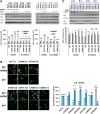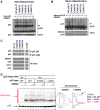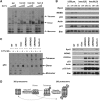Wild-type and cancer-related p53 proteins are preferentially degraded by MDM2 as dimers rather than tetramers
- PMID: 29549180
- PMCID: PMC5900715
- DOI: 10.1101/gad.304071.117
Wild-type and cancer-related p53 proteins are preferentially degraded by MDM2 as dimers rather than tetramers
Abstract
The p53 tumor suppressor protein is the most well studied as a regulator of transcription in the nucleus, where it exists primarily as a tetramer. However, there are other oligomeric states of p53 that are relevant to its regulation and activities. In unstressed cells, p53 is normally held in check by MDM2 that targets p53 for transcriptional repression, proteasomal degradation, and cytoplasmic localization. Here we discovered a hydrophobic region within the MDM2 N-terminal domain that binds exclusively to the dimeric form of the p53 C-terminal domain in vitro. In cell-based assays, MDM2 exhibits superior binding to, hyperdegradation of, and increased nuclear exclusion of dimeric p53 when compared with tetrameric wild-type p53. Correspondingly, impairing the hydrophobicity of the newly identified N-terminal MDM2 region leads to p53 stabilization. Interestingly, we found that dimeric mutant p53 is partially unfolded and is a target for ubiquitin-independent degradation by the 20S proteasome. Finally, forcing certain tumor-derived mutant forms of p53 into dimer configuration results in hyperdegradation of mutant p53 and inhibition of p53-mediated cancer cell migration. Gaining insight into different oligomeric forms of p53 may provide novel approaches to cancer therapy.
Keywords: 20S proteasome; MDM2; mutant p53; nuclear export; p53 dimer; p53 tetramer.
© 2018 Katz et al.; Published by Cold Spring Harbor Laboratory Press.
Figures






Similar articles
-
Oligomerization conditions Mdm2-mediated efficient p53 polyubiquitylation but not its proteasomal degradation.Int J Biochem Cell Biol. 2010 May;42(5):725-35. doi: 10.1016/j.biocel.2010.01.010. Epub 2010 Jan 18. Int J Biochem Cell Biol. 2010. PMID: 20080206
-
Controlled access of p53 to the nucleus regulates its proteasomal degradation by MDM2.Mol Pharm. 2013 Apr 1;10(4):1340-9. doi: 10.1021/mp300543t. Epub 2013 Mar 1. Mol Pharm. 2013. PMID: 23398638 Free PMC article.
-
Regulation of p53 nuclear export through sequential changes in conformation and ubiquitination.J Biol Chem. 2007 May 11;282(19):14616-25. doi: 10.1074/jbc.M610515200. Epub 2007 Mar 19. J Biol Chem. 2007. PMID: 17371868
-
The p53-Mdm2 module and the ubiquitin system.Semin Cancer Biol. 2003 Feb;13(1):49-58. doi: 10.1016/s1044-579x(02)00099-8. Semin Cancer Biol. 2003. PMID: 12507556 Review.
-
p53 regulation: teamwork between RING domains of Mdm2 and MdmX.Cell Cycle. 2011 Dec 15;10(24):4225-9. doi: 10.4161/cc.10.24.18662. Epub 2011 Dec 15. Cell Cycle. 2011. PMID: 22134240 Review.
Cited by
-
Regulation of the MDM2-p53 pathway by the ubiquitin ligase HERC2.Mol Oncol. 2020 Jan;14(1):69-86. doi: 10.1002/1878-0261.12592. Epub 2019 Nov 15. Mol Oncol. 2020. PMID: 31665549 Free PMC article.
-
Stepwise multipolyubiquitination of p53 by the E6AP-E6 ubiquitin ligase complex.J Biol Chem. 2019 Oct 11;294(41):14860-14875. doi: 10.1074/jbc.RA119.008374. Epub 2019 Sep 6. J Biol Chem. 2019. PMID: 31492752 Free PMC article.
-
The ubiquitin ligase TRIM21 regulates mutant p53 accumulation and gain of function in cancer.J Clin Invest. 2023 Mar 15;133(6):e164354. doi: 10.1172/JCI164354. J Clin Invest. 2023. PMID: 36749630 Free PMC article.
-
The Ashkenazi-Centric G334R Variant of TP53 is Severely Impaired for Transactivation but Retains Tumor Suppressor Function in a Mouse Model.Mol Cell Biol. 2024;44(12):607-621. doi: 10.1080/10985549.2024.2421885. Epub 2024 Nov 8. Mol Cell Biol. 2024. PMID: 39520074
-
p53 tetramerization: at the center of the dominant-negative effect of mutant p53.Genes Dev. 2020 Sep 1;34(17-18):1128-1146. doi: 10.1101/gad.340976.120. Genes Dev. 2020. PMID: 32873579 Free PMC article. Review.
References
-
- Asher G, Shaul Y. 2006. Ubiquitin-independent degradation: lessons from the p53 model. Isr Med Assoc J 8: 229–232. - PubMed
-
- Asher G, Reuven N, Shaul Y. 2006. 20S proteasomes and protein degradation ‘by default’. Bioessays 28: 844–849. - PubMed
-
- Bargonetti J, Manfredi JJ, Chen XB, Marshak DR, Prives C. 1993. A proteolytic fragment from the central region of P53 has marked sequence-specific DNA-binding activity when generated from wild-type but not from oncogenic mutant P53-protein. Genes Dev 7: 2565–2574. - PubMed
Publication types
MeSH terms
Substances
Grants and funding
LinkOut - more resources
Full Text Sources
Other Literature Sources
Research Materials
Miscellaneous
